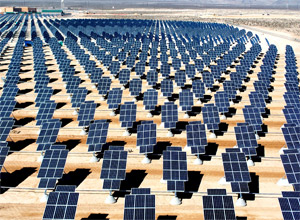
Solar Energy
According to the US Energy Information Administration, humanity's total need for energy amounts to about 20 trillion kilowatt-hours in 2010 and will grow to more than 30 trillion kilowatt-hours by 2030. Right now, the majority of this energy need is met by burning fossil fuels (natural gas, coal, and oil). Because the supply of these fuels is dwindling and they have many negative effects on the environment, renewable energy sources — energy sources that are naturally replenished and cannot be depleted — have taken on a new global importance. One of the most abundant renewable energy sources is solar energy. On a cloudless day, each square meter of Earth's surface is bombarded with about one kilowatt of energy in a single hour of sunlight. Put another way, the amount of solar energy that hits the surface of the earth in one hour is greater than the total amount of energy that the entire human population requires in a year. No wonder many scientists and policy makers are searching for ways to make solar energy a larger part of our energy strategy in the future.
Some solar energy is already being captured for human use. There are three types of solar energy technology widely available today. Photovoltaic cells, first developed at Bell Labs in 1954, contain semiconducting materials that absorb light energy from the sun and produce a flow of electrical energy in response. These are the familiar rectangular panels seen on satellites and the roofs of some homes. Concentrating solar power, developed by the US Department of Energy in 1982, uses mirrors to reflect and concentrate sunlight onto receivers containing a heat-absorbing fluid. The heated fluid is then used to boil water for steam, which turns a steam turbine. The steam turbine then drives a generator, producing electricity. Solar heating uses solar collecting panels that contain tubes of heat-absorbing fluid to provide heat or hot water to buildings or pools.
Despite these and other advances in solar energy technology, less than one percent of the total human energy need is currently filled by solar energy. Why has solar energy not made a larger dent in our global energy problem? Certainly, the hindrance to broader adoption of solar energy is not a lack of supply. Rather, the main challenge is capturing and transporting solar energy to energy grids in a cost-effective and environmentally friendly way. Solar power plants, such as the Solar Energy Generating Systems plants in California's Mojave Desert and the Nevada Solar One plant in Las Vegas, can provide clean energy to the grid but require large tracts of land and, often, large amounts of water for cooling, raising environmental concerns. This has stymied the construction of these plants in the US. Individual residents can deploy their own personal solar panels and solar water heaters, but these devices are very expensive to manufacture and install, putting them out of reach for most homeowners without the support of large government subsidies. As a result, although solar energy technology has come a long way over the past ten years, the cost per kilowatt-hour of solar energy is still generally much higher than the cost per kilowatt-hour of fossil fuel based energy.
The potential benefits — and many challenges — of solar energy raise a host of important questions for our society. How can the cost of solar energy be reduced so that it becomes competitive with fossil fuel energy? Should government, industry, or consumers take the lead in this effort? Are large-scale government subsidies an economically feasible solution given current global economic challenges? How can the environmental impact of large solar power plants be mitigated?
In this Spotlight, we guide you through a range of perspectives on these critical questions. We look at the mechanics of solar energy production, recent developments in the solar energy industry, the environmental impact of solar energy, and solar energy economics. We also look at promising emerging technologies that may improve solar energy efficiency and reduce costs, bringing solar energy one step closer to parity with traditional energy sources.
Image: Stocktrek Images/Getty Images.
How solar energy works
Explore the science of photovoltaics and their use in solar energy systems.
This NOVA interactive module takes you inside the anatomy of a photovoltaic cell.
Learn how solar power relies on mirrors to reflect and concentrate sunlight.
Research discoveries
Researchers at EMPA have developed a "recipe" for thin film solar cells that are both cost-effective to manufacture and highly energy-efficient.
MIT Technology Review reports that the optical properties of nanowires may allow for solar cells that use less materials while converting energy more efficiently.
Combining the strengths of two solar technologies, photovoltaics and solar thermal, may yield efficient solar panels that work even when it's not sunny.
Solar energy and industry
Solar currently represents less than one percent of US energy production.
Read about the latest developments in solar power plant technology.
California is betting on solar power as a means to serve its energy needs.
Economics of solar energy
Solar Today offers advice to homeowners trying to figure out the value of installing a solar electricity system for powering their homes.
The research and consulting firm SolarBuzz calculates monthly Solar Electricity Benchmark Price Indices. Compare the price of solar electricity and fossil fuel-based electricity.
In this video, WSJ reporter Gwendolyn Bounds installs a solar hot water system in her house and walks through the process and the incentives.
Environmental Impact
As solar power plants require a large amount of water for cooling, the Times takes a look at the environmental and economic impacts of solar energy on water consumption.
Read here to see how the National Renewable Energy Laboratory is meeting the challenge of conserving native vegetation and wildlife at their new photovoltaic array near Boulder, CO.
Photovoltaic panels have a lifespan of about 25 years. Learn about US and European efforts to set up recycling processes for the growing amount of solar panel waste.



























